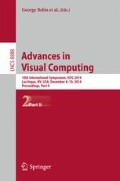Abstract
We present algorithms for depth estimation from light-field data acquired by a multi-line-scan image acquisition system. During image acquisition a 3-D light field is generated over time, which consists of multiple views of the object observed from different viewing angles. This allows for the construction of so-called epipolar plane images (EPIs) and subsequent EPI-based depth estimation. We compare several approaches based on testing various slope hypotheses in the EPI domain, which can directly be related to depth. The considered methods used in hypothesis assessment, which belong to a broader class of block-matching algorithms, are modified sum of absolute differences (MSAD), normalized cross correlation (NCC), census transform (CT) and modified census transform (MCT). The methods are compared w.r.t. their qualitative results for depth estimation and are presented for artificial and real-world data.
Access this chapter
Tax calculation will be finalised at checkout
Purchases are for personal use only
Preview
Unable to display preview. Download preview PDF.
References
Bolles, R.C., Baker, H.H., Marimont, D.H.: Epipolarplane image analysis: an approach to determining structure from motion. Int. J. Comput. Vis. 1(1), 7–55 (1987)
Wanner, S., Goldlücke, B.: Globally consistent depth labeling of 4D light fields. In: Proc. IEEE Conf. on Computer Vision and Pattern Recognition (CVPR), Providence, RI, pp. 41–48. IEEE (2012)
Kim, C., Zimmer, H., Pritch, Y., Sorkine-Hornung, A., Gross, M.H.: Scene reconstruction from high spatio-angular resolution light fields. ACM Trans. Graph. 32(4), 73:1–73:12 (2013)
Venkataraman, K., Lelescu, D., Duparré, J., McMahon, A., Molina, G., Chatterjee, P., Mullis, R., Nayar, S.: PiCam: an ultra-thin high performance monolithic camera array. ACM Trans. Graph. 32(6), 166:1–166:13 (2013)
Levoy, M., Hanrahan, P.: Light field rendering. In: Proc. Conf. on Computer Graphics and Interactive Techniques, SIGGRAPH, pp. 31–42. ACM, New York (1996)
Wilburn, B., Joshi, N., Vaish, V., Talvala, E.-V., Antunez, E., Barth, A., Adams, A., Horowitz, M., Levoy, M.: High performance imaging using large camera arrays. ACM Trans. Graph. 24(3), 765–776 (2005)
Davis, A., Levoy, M., Durand, F.: Unstructured light fields. Comput. Graph. Forum 31(2pt.1), 305–314 (2012)
Liang, C.-K., Lin, T.-H., Wong, B.-Y., Liu, C., Chen, H.H.: Programmable aperture photography: multiplexed light field acquisition. ACM Trans. Graph. 27(3), 55:1–55:10 (2008)
Ng, R., Levoy, M., Brédif, M., Duval, G., Horowitz, M., Hanrahan, P.: Light field photography with a hand-held plenoptic camera, Tech. Rep. CSTR 2005-02, Stanford University (April 2005)
Lumsdaine, A., Georgiev, T.: The focused plenoptic camera. In: Proc. IEEE Int. Conf. on Computational Photography (ICCP), San Francisco, CA, pp. 1–8. IEEE (2009)
Perwaß, C., Wietzke, L.: Single lens 3D-camera with extended depth-of-field. In: Proc. of SPIE – Human Vision and Electronic Imaging XVII, vol. 8291, pp. 829108-1–829108-15 (2012)
Štolc, S., Soukup, D., Holländer, B., Huber-Mörk, R.: Depth and all-in-focus imaging by a multi-line-scan light-field camera. Journal of Electronic Imaging 23(5), 053020 (2014)
Štolc, S., Huber-Mörk, R., Holländer, B., Soukup, D.: Depth and all-in-focus images obtained by multi-line-scan light-field approach. In: Niel, K.S., Bingham, P.R. (eds.) Proc. of SPIE-IS&T Electronic Imaging – Image Processing: Machine Vision Applications VII, San Francisco, CA (February 2014)
Zabih, R., Woodfill, J.: Non-parametric local transforms for computing visual correspondence. In: Eklundh, J.-O. (ed.) ECCV 1994. LNCS, vol. 801, pp. 151–158. Springer, Heidelberg (1994)
Cyganek, B.: Comparison of nonparametric transformations and bit vector matching for stereo correlation. In: Klette, R., Žunić, J. (eds.) IWCIA 2004. LNCS, vol. 3322, pp. 534–547. Springer, Heidelberg (2004)
Ambrosch, K., Zinner, C., Kubinger, W.: Algorithmic considerations for real-time stereo vision applications. In: Proc. Machine Vision and Applications (MVA), Keio University, Yokohama, JP, pp. 231–234 (May 2009)
Author information
Authors and Affiliations
Editor information
Editors and Affiliations
Rights and permissions
Copyright information
© 2014 Springer International Publishing Switzerland
About this paper
Cite this paper
Soukup, D., Huber-Mörk, R., Štolc, S., Holländer, B. (2014). Depth Estimation within a Multi-Line-Scan Light-Field Framework. In: Bebis, G., et al. Advances in Visual Computing. ISVC 2014. Lecture Notes in Computer Science, vol 8888. Springer, Cham. https://doi.org/10.1007/978-3-319-14364-4_45
Download citation
DOI: https://doi.org/10.1007/978-3-319-14364-4_45
Publisher Name: Springer, Cham
Print ISBN: 978-3-319-14363-7
Online ISBN: 978-3-319-14364-4
eBook Packages: Computer ScienceComputer Science (R0)

